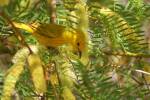Project takes flight to track hummingbirds at Red Rock Canyon
Editor’s note: This story has been modified from its original version to reflect that hummingbirds need sugar water one part sugar to four parts water.
It’s a task for early birds, and it’s all about early birds. For the past year, Red Rock Canyon has been involved in the seasonal coordinated monitoring program for the Hummingbird Monitoring Network.
This day, June 13, the effort started just shy of 5 a.m., even before the sun rose. A crew of specially trained volunteers removed four of the hummingbird feeders at the back of the Visitor Center and affixed custom-made traps to the two remaining ones. They ran trip lines to the traps, securing the ends near folding chairs about 12 feet away.
Then two of them took their seats and waited. They didn’t wait long. A hummingbird zoomed in and hovered at different levels as it assessed the situation. Finding no threat, it darted in for a drink of sugar water.
“They’re just so smart,” said Cindy Stokes, a volunteer. “That’s what freaks me out about them.”
Well, maybe not that smart. When the hummingbird perched, the volunteer hit the trigger. The net snapped down, capturing the bird. The volunteer hurried over, stuck her hand under the net and snatched the trapped bird. She slid it gently into a mesh bag.
“The first time I did it, I was afraid to grab it,” Stokes said. “I was afraid I was going to hurt it. But they’re actually pretty (sturdy).”
The bird was taken to Amelia Savage, a wildlife biologist with the Bureau of Land Management, who had a plethora of tools — a weight scale, calipers, pliers, a flashlight, magnifying glasses, a reference book and a clipboard with tally sheet — laid out on an outdoor picnic table in a separate area. Savage pulled the bird from the bag, and the exam began.
Measurements were taken. A scribe volunteer marked a sheet with various categories, including the species, estimated age, total length, wing feather length and molting status.
Most of the tools Savage used were precision instruments. One was noticeably not. Savage took out a soda straw that had been clipped to about 4 inches. She used it to blow open the neck feathers to observe the area where fat forms and rated it.
Using pliers, she carefully secured a tiny band of aluminum to the bird’s leg. Each band has a unique ID, one letter and five digits. The final measurement was for weight. For that, the bird was wrapped gently in mesh, a clip holding it together.
“This one’s a fat one, 3.67 grams,” Savage said.
In comparison, a penny weighs 2.5 grams, said Susan Wethington, executive director of the Hummingbird Monitoring Network. She joked that one could mail seven hummingbirds in a first-class letter.
While being handled, the hummingbirds seemed calm and were not resisting.
“Just a few of them act up a little bit,” said Carla Wise, a BLM wildlife biologist.
If a bird was already banded, the vitals taken this day would be compared to its last capture. The gender was also noted.
“The males are easy,” Wethington said. “They’ve got the beautiful gorget.”
Gorget refers to the throat feathers, which are colorful on the males. There’s another way to tell the difference.
“You can sometimes see the egg forming in the females,” Savage said, adding that hummingbirds have clutches of only two eggs with each gestation. “They’re the size of jelly beans.”
Then the tiny bird was held to a feeder on the table to keep it hydrated. Set on an open palm, it paused to regain its legs before taking off.
The program started about a year ago, running spring to fall. This year’s effort began in February, taking place every other week. So far, Savage’s team has collected data on more than 200 hummingbirds, she said. Team members can see as many as 36 birds in their four-hour stretch of trapping or as few as two.
Red Rock Canyon sees mostly three species of the birds — the Black-chinned, the Costa’s and Anna’s –– with Anna’s being the most prevalent.
The tracking will help further knowledge about the small birds. The network has 30 study sites running in North America. The next closest one is in Utah. While migration routes and information such as gestation are known, there is still much that is not. No one is even sure how long they live.
“We don’t yet have good estimates on life expectancy,” Wethington said. “We used to say three to five years. But now that the study is functioning, we’re getting good data, and it’s not unusual for us to catch 8-, 9- or 10-year-old birds. That’s really surprising because it’s such a small animal. ... There’s a relationship between body size and longevity. The longest longevity record is 12 years, three months.”
She said she was interested in seeing how climate change was affecting the birds.
Hummingbirds need sugar water in a one-to-four ratio. The water should be changed out and the feeder washed as bacteria can build up. How frequently depends on whether it’s glass or plastic and in the sun or shade.
“I like to say, If you look at your hummingbird feeder and you say, ‘Yeah, I’ll drink that,’ then it’s OK,” Wethington said.
She suggested the book “Do Hummingbirds Hum?” by George C. West for those who want to know more about the birds.
By 7:30 a.m. the group had captured 16 birds, a few of them repeats.
“This is a part of Red Rock most people don’t get to see,” Savage said.
The daybreak effort matches the time when the birds wake and need nourishment. By having six feeders at the Visitor Center, the birds are encouraged to start their day there.
The volunteers had their coffee and caffeinated sodas nearby, and even so, they all claimed sacrificing sleep to capture hummingbirds was no hardship.
“I get up early anyway,” said Jennifer Vincent, an interpretive naturalist. “Today I got up about 3:45.”
Savage is set to move to a new assignment in North Dakota at the end of June. With her departure, the tracking will be put on hiatus until a new person is trained to oversee the program. Wethington said the effort at Red Rock Canyon would probably resume in April.
For more information on the program, visit hummonnet.org.
Contact Summerlin/Summerlin South View reporter Jan Hogan at jhogan@viewnews.com or 702-387-2949.
Find out more
To find out more about the Hummingbird Monitoring Network’s seasonal coordinated monitoring program, visit hummonnet.org.
































